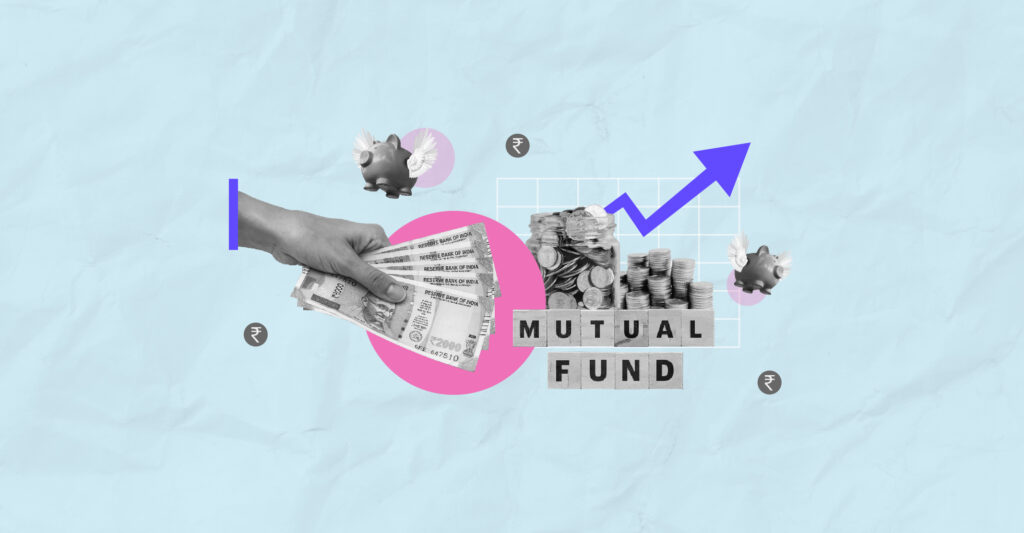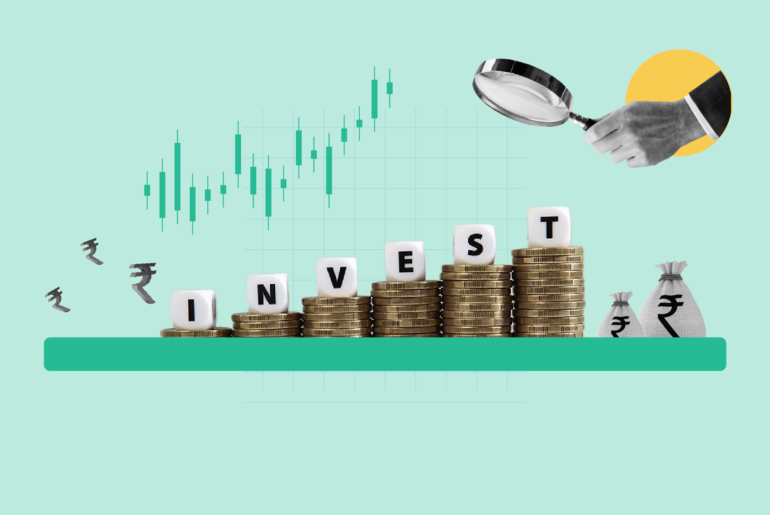Last Updated on Nov 19, 2024 by Vanessa Sequeira
If you’re looking to grow your wealth over time without the constant need to monitor the stock market, high-return mutual funds may sound like the perfect fit. They offer the potential for substantial returns compared to other investment options. But, while the allure of high returns is tempting, it’s essential to understand that the best CAGR mutual funds often come with greater volatility and risk. Therefore, investors should be prepared for the ups and downs that may accompany these higher rewards.
In this guide, we’ll explore the top 10 high return mutual funds in India based on their 3-year CAGR and how to decide if they align with your financial goals.
Table of Contents
Top 10 High Return Mutual Funds in India for Long-Term in 2024 (Large-cap)
| Name | AUM (in Cr.) | CAGR 3Y (%) | Expense Ratio (%) |
| Nippon India Large Cap Fund | 34,432.09 | 18.96 | 0.67 |
| HDFC Top 100 Fund | 36,467.34 | 16.20 | 0.99 |
| ICICI Pru Bluechip Fund | 63,669.82 | 16.15 | 0.87 |
| JM Large Cap Fund | 456.66 | 15.82 | 0.66 |
| Baroda BNP Paribas Large Cap Fund | 2,348.71 | 15.34 | 0.82 |
| DSP Top 100 Equity Fund | 4,470.18 | 14.97 | 1.08 |
| Edelweiss Large Cap Fund | 1,081.39 | 14.69 | 0.67 |
| Invesco India Largecap Fund | 1,255.06 | 13.90 | 0.72 |
| Bandhan Large Cap Fund | 1,744.59 | 13.48 | 0.92 |
| HSBC Large Cap Fund | 1,928.20 | 13.27 | 1.18 |
Note: The list of top 10 high-return large-cap high CAGR mutual funds is curated using Tickertape Mutual Fund Screener on the date 13th November 2024 by using the following parameters:
- Category: Equity > Large cap fund
- Plan: Growth
- 3-yr CAGR: Sorted from highest to lowest
🚀 Pro Tip: You can use Tickertape’s Stock Screener to research and evaluate stocks with over 200+ filters and parameters.
Confused about which mutual funds to pick? Consider exploring smallcases:
smallcases are modern investment products that help investors build low-cost, long-term & diversified portfolios with ease. A smallcase is a basket or portfolio of stocks/ETFs representing an idea – an objective, theme, or strategy. They are created and managed by SEBI-registered experts.
Some of the popular smallcases amongst new investors are as follows:
Note: These smallcases are mentioned only for educational purposes and are not meant to be recommendatory. Investors must conduct their own research and consult a financial expert before making any investment decisions.
Disclosures for the aforementioned smallcases.
Overview of the Top 10 High Return Mutual Funds (Large-Cap)
Nippon India Large Cap Fund
Nippon India Mutual Fund, among India’s best CAGR mutual funds, manages an impressive Average Assets Under Management (AAUM) of ₹2,79,431 crore. Sponsored by Nippon Life Insurance Company, this fund operates as a trust under the Indian Trusts Act of 1882, with Nippon Life India Trustee Ltd as its trustee. The current Net Asset Value (NAV) stands at ₹95.38, reflecting its performance in the large-cap segment. Utilise the Tickertape MF screener tool for more information on the performance of the fund.
HDFC Top 100 Fund
Managed by HDFC Asset Management Company, HDFC Top 100 Fund is backed by a strong joint venture between HDFC and Standard Life Investments (SLI). As one of the leading AMCs in India, HDFC AMC is notable for offering some of the best CAGR mutual funds in India. The fund’s current NAV is ₹1,187.90, indicative of its value and solid presence in the large-cap category.
ICICI Prudential Bluechip Fund
ICICI Prudential Asset Management Company Ltd., recognised as a top AMC in India, operates the ICICI Prudential Bluechip Fund. Formed as a joint venture between ICICI Bank and Prudential Plc, a UK-based financial leader, this top 10 CAGR mutual fund is well-positioned in the large-cap space with a NAV of ₹114.32.
JM Large Cap Fund
JM Financial Asset Management, part of the legacy JM Financial Group, began operations in 1993-94, making it one of India’s oldest private AMCs. It leverages its established reputation to offer the JM Large Cap Fund, which currently has a NAV of ₹175.71. This fund appeals to investors who are looking for the best CAGR mutual funds in India in terms of historical stability and strong growth.
Baroda BNP Paribas Large Cap Fund
Baroda BNP Paribas Mutual Fund is a collaboration between Bank of Baroda and BNP Paribas Asset Management, offering global expertise and active investment strategies. With a NAV of ₹247.35, this large-cap fund benefits from its strong international partnership. Investors seeking the top 10 CAGR mutual funds should analyse this fund on the Tickertape MF screener.
DSP Top 100 Equity Fund
Launched in 1996, DSP Investment Managers is part of the renowned DSP Group, which has roots in Indian finance dating back over 150 years. Known for its long-term track record, the DSP Top 100 Equity Fund has a NAV of ₹490.71, reflecting its stability and growth within the large-cap category. For those exploring which mutual fund has the highest CAGR, DSP is on the list of some of the best CAGR mutual funds.
Edelweiss Large Cap Fund
Edelweiss Asset Management Limited, one of India’s rapidly growing young AMCs, manages the Edelweiss Large Cap Fund. With a NAV of ₹92.68, the fund is part of the Edelweiss Group’s Investment & Advisory business line. Investors seeking high-return mutual funds in the large-cap space should check out these mutual funds on Tickertape.
Invesco India Largecap Fund
Invesco, an Atlanta-based global investment manager with operations in 25 countries, offers the Invesco India Largecap Fund. With a current NAV of ₹78.98, this fund brings international investment expertise to the Indian market. This top 10 CAGR mutual fund is appealing to those interested in the best CAGR mutual funds in India.
Bandhan Large Cap Fund
Launched on June 9, 2006, the Bandhan Large Cap Fund represents Bandhan Mutual Fund House’s significant equity offering. Its NAV of ₹84.09 showcases its growth since inception, making it a standout in the large-cap equity sector. Research the performance of mutual funds on Tickertape for those analysing which mutual fund has the highest CAGR.
HSBC Large Cap Fund
HSBC Global Asset Management, with a substantial presence in India, serves over a million customers through its extensive network of branches. The HSBC Large Cap Fund, backed by this global name, has a NAV of ₹515.26, reflecting its strong position in the large-cap space. Check out the performance of the fund on tools like the Tickertape MF screener.
Top 10 High Return Mutual Funds in India (Mid-Cap) in 2024
| Name | AUM (in Cr.) | CAGR 3Y (%) | Expense Ratio (%) |
| Motilal Oswal Midcap Fund | 20,055.68 | 32.57 | 0.58 |
| HDFC Mid-Cap Opportunities Fund | 77,682.90 | 25.51 | 0.72 |
| Edelweiss Mid Cap Fund | 7,677.01 | 24.41 | 0.4 |
| Quant Mid Cap Fund | 8,940.54 | 24.20 | 0.58 |
| Mahindra Manulife Mid Cap Fund | 3,340.74 | 23.99 | 0.48 |
| Nippon India Growth Fund | 33,922.40 | 23.69 | 0.79 |
| Sundaram Mid Cap Fund | 12,350.49 | 22.81 | 0.87 |
| Invesco India Midcap Fund | 5,624.96 | 22.69 | 0.58 |
| HSBC Midcap Fund | 11,767.99 | 22.38 | 0.66 |
| Kotak Emerging Equity Fund | 50,627.29 | 22.24 | 0.38 |
Note: The list of top 10 high-return mid-cap mutual funds is curated using Tickertape Mutual Fund Screener on the date 13th November 2024 by using the following parameters
- Category: Equity > Mid cap fund
- Plan: Growth
- 3-yr CAGR: Sorted from highest to lowest
Top 10 High-Return Small-Cap Mutual Funds in 2024
| Name | AUM (in Cr.) | CAGR 3Y (%) | Expense Ratio (%) |
| Bandhan Small Cap Fund | 8716.22 | 27.66 | 0.38 |
| Nippon India Small Cap Fund | 61027.03 | 27.35 | 0.68 |
| Quant Small Cap Fund | 26330.82 | 25.83 | 0.64 |
| Tata Small Cap Fund | 9319.04 | 25.51 | 0.29 |
| Invesco India Smallcap Fund | 5352.82 | 24.29 | 0.41 |
| HSBC Small Cap Fund | 16919.61 | 24.21 | 0.67 |
| Bank of India Small Cap Fund | 1516.96 | 23.75 | 0.48 |
| HDFC Small Cap Fund | 33504.02 | 23.39 | 0.68 |
| Franklin India Smaller Cos Fund | 13943.92 | 23.33 | 0.89 |
| LIC MF Small Cap Fund | 385.61 | 23.22 | 1.53 |
Note: This Tickertape mutual fund list of top 10 high-return small-cap mutual funds is curated using Tickertape Mutual Fund Screener on the date 13th November 2024 by using the following parameters –
- Category: Equity > Small cap fund
- Plan: Growth
- 3-yr CAGR: Sorted from highest to lowest
What are High-Return Mutual Funds?
High return mutual funds deliver above-average returns by focusing on high-growth sectors, aggressive strategies, or specific asset classes. High-return mutual funds carry high risks. Their risk-to-return ratio is also significantly higher. They typically invest in equity, which is known for its specific risk-reward dynamic. These mutual funds with the highest CAGR can typically provide you with high returns. This means that while you may achieve substantial profits with a mutual fund with the best return, you may just as quickly lose your investment amount.
These high-return mutual funds are often volatile and unpredictable. High-return mutual funds in 2024 are particularly suitable for investors with an aggressive risk appetite who are prepared for significant fluctuations.
Features of High-Return Mutual Funds
- Various types: The Securities Exchange Board of India (SEBI) has classified ten sub-categories of equity mutual funds. It includes large, mid, and small-cap funds, ELSS funds, focused funds, dividend-yielding funds, thematic and sector funds, etc. Therefore, investors have a broad range of mutual funds with the highest CAGR to choose from
- Risk-reward ratio: The phrase ‘higher the risk, higher the reward’ was perhaps coined for high-return mutual funds. The CAGR of mutual funds in India and their risk-to-return ratio often go hand in hand.
- Asset allocation: Equity funds allocate 65% to 80% of assets in equities. Therefore, they are known as ‘high-risk funds’. In a bullish trend, this high asset allocation can be proved to be incredibly profitable while the chances of losses increase in the bearish market.
- Tax benefits: High-return mutual funds can give you tax benefits. For instance, with ELSS funds, there is an option to claim deductions of up to Rs. 1,50,000 under Section 80C. However, you have to pay short-term and long-term capital gains on your returns.
- Investment modes: You can invest in a mutual fund with the highest CAGR in two ways: Systematic Investment Plan (SIP) and lumpsum. The minimum SIP investment goes as low as Rs. 150.
Taxation on Equity Mutual Funds as per the 2024 Budget
Understanding the latest tax regulations on equity mutual funds is essential for making informed investment decisions. The Union Budget 2024 has introduced significant changes to the taxation of equity mutual funds, simplifying the tax structure while altering rates and benefits. Here is a detailed breakdown of the new tax rules:
Short-Term Capital Gains (STCG)
If you hold equity mutual funds for less than a year, the gains from these investments are classified as short-term capital gains. According to the new budget, these gains are now taxed at a rate of 20%, which has been increased from the previous rate of 15%.
Long-Term Capital Gains (LTCG)
For equity mutual funds held for more than a year, the gains are considered long-term capital gains. The key points to note under the new budget are:
- Tax-Free Limit: Gains up to Rs. 1.25 lakh in a financial year remain tax-free. This limit has been increased from the previous threshold of Rs. 1 lakh.
- Tax Rate: Any gains above Rs. 1.25 lakh are taxed at a flat rate of 12.5%. It was previously taxed at 10%.
- Indexation: It’s important to note that the benefit of indexation, which previously allowed investors to adjust the purchase price of their assets for inflation, has been removed for all asset classes, including equity mutual funds.
Indexation is a method used to adjust the purchase price of an asset (like property or gold) for inflation over the years. This adjusted price is then used to calculate capital gains. Previously, long-term capital gains from selling property, gold, or other unlisted assets were taxed at 20%, but you could use indexation to reduce your taxable profit. The new rule simplifies the tax structure by setting a flat 12.5% tax rate for all long-term capital gains. However, it removes the indexation benefit.
Advantages of Investing in High-Return Mutual Funds
- Potential for Wealth Creation: High-return mutual funds can accelerate wealth growth, especially when held for long periods, as they are designed to outperform traditional savings options and other conservative investments.
- Compounding Effect: Returns are reinvested, allowing even small investments to grow significantly over time as earnings generate further gains in a compounding cycle, creating exponential growth.
- Professional Management: Every mutual fund with the best return is managed by financial experts who analyse market trends, adjusting their strategies to maximise potential gains. This ensures that each mutual fund with the highest CAGR can achieve its performance targets based on current market conditions and insights.
- Diversification: By investing across a variety of sectors and asset classes, high-return mutual funds spread risk, potentially shielding investors from losses associated with individual assets.
- Liquidity: Mutual funds offer ease of entry and exit, allowing investors the flexibility to redeem units based on financial needs, often without large penalties.
How Returns are Calculated in High-Return Mutual Funds?
Here’s how returns are calculated in high-return mutual funds:
- Simple Return Calculation: To find the basic return percentage, subtract the initial Net Asset Value (NAV) from the current NAV. Then, divide this difference by the initial NAV and multiply by 100. This formula shows the percentage growth of your investment.
- Compounded Annual Growth Rate (CAGR): This formula helps calculate the average annual growth rate of an investment over a period, considering compounding. It smooths out fluctuations to show what consistent yearly growth would look like. For example, if your investment grows from ₹1,00,000 to ₹1,50,000 in 3 years, the CAGR tells you the fixed annual growth rate (approximately 14.47%).
- XIRR (Extended Internal Rate of Return): This is used for investments with irregular cash flows like SIPs. It factors in the amount and timing of each cash flow to determine an annualised return. It calculates the return by considering the exact dates of cash inflows (investments) and outflows (redemptions), providing an accurate annualised return.
How to Choose the Best High-Return Mutual Funds for Investing?
The top 10 high return mutual funds in India NSE often show a pattern of strong returns, but careful consideration is needed when selecting them:
- Assess Performance History: Review how the fund has performed across different market cycles to understand its potential to deliver consistent returns, though always considering that past performance may not predict future outcomes. Remember that even the highest return giving mutual fund may not guarantee future results based on past performance.
- Understand the Fund Objective: Ensure the fund’s goals align with your own—such as aggressive growth or moderate income—and consider if it fits your investment timeline and risk profile. This ensures that your choice from the top 10 high return mutual funds in India NSE fits your investment timeline and risk profile.
- Evaluate Risk Factors: High-risk funds, often classified as high-risk, high-return mutual funds, come with significant volatility. Select options that align with your risk tolerance, whether it’s conservative or leaning towards mutual funds with the best rolling returns.
- Consider Expense Ratios: Lower expenses can impact long-term returns positively, as high management fees can reduce the net gains you receive.
- Check Fund Manager’s Track Record: The best rolling returns mutual fund in India may owe its success to a skilled manager. Research their experience, previous funds managed, and strategies implemented.
Factors to Consider Before Investing in High Return Mutual Funds
- Investment objective: Before diving into any mutual fund, assess if its objectives align with your financial goals. Are you saving for retirement, a child’s education, or building an emergency fund? The fund’s strategy should match your timeline and risk tolerance.
- Risk tolerance: Understand that high-risk, high-return mutual funds come with potential volatility. Evaluate your risk appetite. Can you tolerate the volatility that comes with the potential for higher returns, or would a safer investment make you sleep better at night? It is crucial to decide this before you step into any investment.
- Performance history: While past performance isn’t a guarantee of future results, it can provide insights into how the fund has managed under various market conditions. Look for consistent performance over a longer period rather than short-term gains.
- Expense ratio and fees: High fees can eat into your returns. Understand the fund’s expense ratio and any additional fees associated with buying, holding, or selling the fund. Lower costs mean more of your money stays invested.
- Fund manager’s expertise and track record: The fund manager’s decisions play a crucial role in the fund’s performance. Research their experience, investment philosophy, and performance history with other funds.
- Asset allocation and diversification: Investigate the fund’s holdings to ensure it’s well-diversified across sectors, geographies, and asset classes. Diversification can help mitigate risk.
- Market conditions: Economic and market conditions can impact fund performance. Consider the current market cycle and how it aligns with the fund’s investment strategy and your own investment objectives.
Risks Associated with High Return Mutual Funds
- Market Risk: The value of investments can go down as well as up due to market fluctuations. High return funds often invest in volatile segments, exposing you to greater market risk.
- Credit Risk: This applies to debt mutual funds. If the issuer of the bond fails to pay interest or repay the principal, it can lead to losses for the fund.
- Interest Rate Risk: For debt funds, changes in interest rates can affect the value of the fund’s holdings. Generally, when interest rates rise, bond prices fall, and vice versa.
- Liquidity Risk: Some of the best mutual funds in India may invest in less liquid assets, making it difficult to sell these investments without impacting their price significantly.
- Concentration Risk: If the fund is heavily invested in a particular sector or company, it’s more vulnerable to downturns in that area.
- Managerial Risk: Poor decisions by the fund manager can lead to underperformance, affecting your investment’s return.
- Operational Risks: Issues like errors in record-keeping, fraud, or other administrative problems can also impact a fund’s performance.
Understanding these risks will empower you to make more informed decisions when considering high return mutual funds in 2024 as part of your investment portfolio. Investing isn’t just about chasing the highest returns; it’s about balancing potential rewards with your comfort level around risk.
To Conclude
High-return mutual funds are mostly equity mutual funds with high risk. However, it is always worthwhile to consult a financial advisor before investing. You can use Tickertape Mutual Fund Screener to sort the top mutual funds based on your preference. With over 50+ filters, you can get the best ticker tape mutual funds based on your preferences. You can keep track of all the ticker tape mutual funds you have invested in using our new Mutual Funds Portfolio, which helps you track the performance of your portfolio effortlessly. Explore the new Portfolio now!
Frequently Asked Questions About High Return Mutual Funds
1. What are the top 10 mutual funds for SIP to invest?
The top CAGR mutual funds for SIP to invest are:
– SBI PSU Fund
– Aditya Birla SL PSU Equity Fund
– Motilal Oswal Midcap Fund
– Invesco India PSU Equity Fund
– ICICI Pru Infrastructure Fund
– HDFC Infrastructure Fund
– DSP India T.I.G.E.R Fund
– LIC MF Infra Fund
– Nippon India Power & Infra Fund
– Franklin Build India Fund
This list of high CAGR mutual funds is based on 13th November 2024. Note that these are equity mutual funds which allow SIP and are some of the highest CAGR mutual funds. The list is sorted using the Tickertape Mutual Fund Screener.
2. What is the significance of the highest CAGR in mutual funds, and how does it impact investment decisions?
The Compound Annual Growth Rate (CAGR) is a crucial measure in mutual funds, indicating the mean annual growth rate of an investment over a specified time period longer than a year. However, while a high CAGR is attractive, it’s essential to consider other factors, such as risk, investment horizon, and market conditions, before making investment decisions.
3. How do I choose among the top 10 high return mutual funds in India?
Choosing among the top 10 high return mutual funds in India involves analyzing several key factors, including past performance, fund manager expertise, investment strategy, risk level, and how well the fund aligns with your financial objectives. It’s also beneficial to look at diversified options across asset classes and sectors to mitigate risk while aiming for high returns.
4. What are the risks associated with investing in mutual funds that offer the highest CAGR?
Investing in mutual funds with the highest CAGR comes with its set of risks, such as market volatility, interest rate risk, and the potential for significant fluctuations in returns. High CAGR values often indicate higher risk levels, as these funds may invest in volatile sectors or employ aggressive investment strategies. Therefore, it’s crucial to assess your risk tolerance and consider a diversified investment approach to mitigate these risks while aiming for high returns.
5. Which mutual funds give 30% return?
The mutual funds with over a CAGR of 30% are listed below:
– SBI PSU Fund
– Aditya Birla SL PSU Equity Fund
– Motilal Oswal Midcap Fund
– Invesco India PSU Equity Fund
– ICICI Pru Infrastructure Fund
– HDFC Infrastructure Fund
– DSP India T.I.G.E.R Fund
Note: These funds are sorted using Tickertape Mutual Fund Screener on 13th November 2024.




